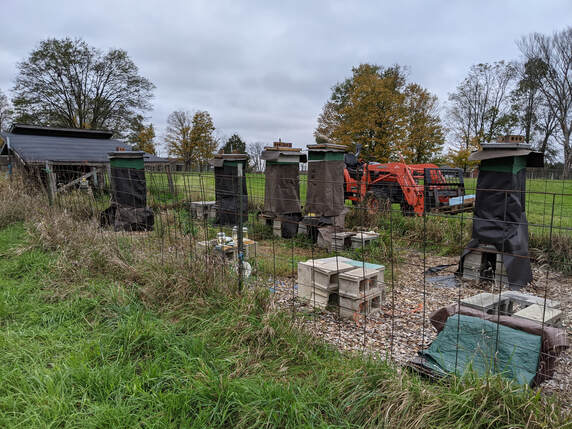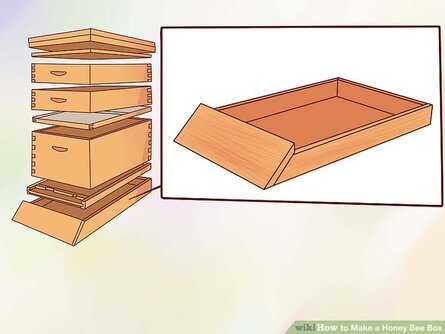 Advance Preparing a hive for winter starts in July with ensuring your bees are healthy (i.e. Varroa mite levels are under control), have ample resources (i.e. honey stores) to last them through the winter, and are queenright and strong (i.e. much easier to for 1 strong, large hive to survive winter than 2 small, weak hives). This means that you may have to feed your hives 2:1 sugar syrup (2 parts sugar to 1 part water) to bulk up their honey stores, and combine weak hives (particularly ones that are queenless, with queenright hives). Many beekeepers will typically also add a windbreak to their apiary in the winter. Common windbreaks include tarps, hay bales, and burlap. Bluster In addition to preparing your bees for winter, many beekeepers in colder climates also choose to prepare their hives for winter to help their bees survive the cold, resourceless months. There are two schools of thought when it comes to this hive preparation: ventilation and insulation. If a beekeeper keeps bees in typical, thin-walled Langstroth hive boxes with an inner cover and telescoping outer cover, and does nothing to prepare the hive structure for winter, they may have moisture problems in the hive. The bees form a cluster during the winter which they keep warm by flexing their wing muscles. Heat and water vapor are generated in this process and will rise to the top of the hive where they will condense on the cold inner and outer covers. The water will then rain down on and chill the bees. Condensation Proponents of ventilating a hive solve this problem by adding a quilt box on top of the hive (under the covers) to trap moisture and an upper entrance to allow air flow to remove the moisture from the top of the hive. They also typically wrap their hives in thin, black tar paper (i.e. roofing felt) to take advantage of the rays of the winter sun to “heat” the hive. Advocates of insulating a hive in the winter argue that upper ventilation lets out all of the heat because in addition to water vapor, heat also rises. They prefer to not have a quilt box or upper entrance and instead wrap their hives in thick foam board wrapped in black plastic and especially add insulation to the top of their hives to prevent the condensation of water vapor over the bee cluster. More Information: Winter Preparation Bees: www.honeybeesuite.com/how-to-prepare-your-hives-for-winter/ Ventilation: https://www.honeybeesuite.com/how-to-wrap-a-hive/ Insulation: https://www.beeculture.com/winter-management/
0 Comments
 Assembly The standard Langstroth beehive is a wooden structure with several key parts. The first part is the bottom board which can be either solid wood or screened, a wooden frame with a screen in the middle to allow ventilation and a form of cultural mite control. The next part of the hive is one or more boxes filled with frames. Then comes the inner cover, a mostly flat piece of wood with a vent hole in the center. Finally, there is a telescoping outer cover that fits over the inner cover and a little bit of the top box to keep out rain and snow. The picture on the left also shows a hive stand which helps to raise a hive off the ground, but isn't a critical part of the hive assembly, and a queen excluder which goes between the brood box and the honey supers, but also isn't required. Boxes There are two lengths of boxes and three different heights of boxes. The two different lengths of boxes are 8-frame and 10-frame, being long enough to fit 8 frames or 10 frames respectively. The three different heights of boxes are deep, medium, and shallow. Deep boxes are typically used for the bee brood, mediums are sometimes used for bee brood, but more often for honey, and shallow boxes are pretty much exclusively used for honey. Because they are mainly used for honey storage, medium and shallow boxes are often referred to as honey supers, while deep boxes are also sometimes called brood boxes. Correct Frames are all the same length (the standard width of the boxes) and three different heights to fit the height of the box. Depending on the height of the frame (and which box they fit), frames are either deep, medium, or shallow frames. While a medium or shallow frame will fit in a deep box, it will not be as high as the box and will leave a gap between the bottom of the frame and the bottom board or the tops of the frames of the box beneath it. Bees will then spend a tremendous amount of energy adding comb to the bottom of the too-short frame to fill the gap, so generally a beekeeper wants to put the correct size frames in the correct boxes. More Information: https://www.uaex.uada.edu/farm-ranch/special-programs/beekeeping/uabeeblog/woodenware-guide.aspx Alternative A Warre hive is a vertical hive like the Langstroth hive with multiple boxes that may be heavy needing to be stacked. Unlike with the Langstroth hive where boxes are removed from the top of the hive stack, with the Warre, boxes are removed from the bottom of the stack. The believed benefits of a Warre hive are that it is “closer to nature” and requires less maintenance, but they only require less maintenance because they have much lower honey yields than a Langstroth hive. Normal maintenance for health, space, and disease are still required. It may be more difficult to find equipment and mentorship for a Warre hive and to test and treat the colony for diseases such as Varroa mite. Bench Mark I strongly recommend starting out with a Langstroth hive as a new beekeeper. Langstroth hive components are the easiest to find and often the most cost efficient. Also, most beekeeping courses, information, books, and internet videos are based on the Langstroth hive design. The main disadvantage of a Langstroth hive is that it can become quite tall and that the heavy boxes can be hard to lift and stack. This can be mitigated by splitting your hive in the spring and removing honey supers in a timely fashion. Climate The main advantage of a Kenyan Top Bar hive is that there is only one box and the colony grows horizontally so the beekeeper will not have to lift boxes off the stack. However, the one long box is quite bulky and heavy if it needs to be moved. Unfortunately, these hives are really meant for a more tropical climate, swarm frequently because the bees run out of space, and generally overwinter poorly because bees in a cluster prefer to move up instead of side to side to reach honey stores. They also either require special frames or are foundationless with very delicate comb that is difficult to handle or test for diseases like Varroa mites. Some people who make beeswax products prefer these hives because the bees need to make a lot of wax. More Information: https://www.honeybeesuite.com/in-praise-of-the-langstroth-hive/  Ancient Beekeeping really started in ancient times with honey hunting and humans harvesting the honey from hives in tree cavities. Traditional honey bee hives kept by the first beekeepers were either conical skeps made of straw or wicker plus mud or wax or cylinders of clay. The problem with these hives is that you have to destroy them to harvest the honey because the comb is fixed (not movable) inside the hive. Skeps are now illegal in some places because they foster poor management and promote disease. Bar The three most common modern beehive designs are the Langstroth hive, the Warre hive, and the Kenyan Top Bar hive. Of these, the Langstroth hive (invented by Rev. Lorenzo Lorraine Langstroth) is by far the most common. One advantage of all of these hives is removable frames that help a beekeeper test for diseases such as Varroa mites and harvest honey without destroying the colony. Langstroth hives and Warre hives are vertical hives, but in Langstroth hives the honey supers go on top of the hive with the brood on the bottom, whereas in a Warre hive, the brood is on the top and the honey is on the bottom. Top Bar hives are horizontal hives with brood in the middle and honey on the edges. Curve There are probably hundreds of different hive designs out there, some designed for aesthetics (garden hives) and some for specific purposes like queen breeding (queen hotels). Still others are meant to simulate the natural habitat of honey bees (log hives). While others try to streamline aspects of beekeeping such as honey harvesting (Flow Hive). Starting out with a more common beehive design will probably help you overcome the steep learning curve in beekeeping and make it a more enjoyable experience. More Information: https://www.smithsonianmag.com/arts-culture/the-secret-to-the-modern-beehive-is-a-one-centimeter-air-gap-4427011/ |
AuthorJen Haeger is a new master beekeeper and board member of A2B2. Archives
August 2022
Categories
All
|


 RSS Feed
RSS Feed
